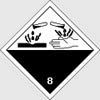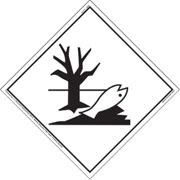Lee G:
I’ve got a feeling Diesel Dave will be answering this one…
Hi Lee,
This is an extremely tricky subject to explain in writing, so I’ll do my best to present the info clearly.
 I’m sticking rigidly to the subject of the question, which relates to the multi-modal carriage of LQs in an ISO container on a journey that involves carriage by both road and sea.
I’m sticking rigidly to the subject of the question, which relates to the multi-modal carriage of LQs in an ISO container on a journey that involves carriage by both road and sea.
Lee G:
I had a job last week of getting a box loaded with LQ’s for export. I’m not worried about if it was LQ’s or not as 99.9% of the companies that we deal with are large blue chip companies that wouldn’t ■■■■ about with anything like that, and all the shipping and DG notes we get for the sea journey all state LQ’s and gives a load of bumpf with it. For those that don’t know dangerous goods by sea (IMDG) are a hell of a lot stricter than by road and not many companies in the world are willing to flaunt them as the penalties can be very very severe.
You’re not kidding there Lee, some of the fines are quite eye-watering!!
As an example, this is what happened to a driver who thought he might try getting away with not declaring to a ferry operator that he was carrying dangerous goods:
 Truck driver fined £5,757.98
Truck driver fined £5,757.98
He was only carrying 383 Kg. Ouch!! 
Lee G:
So do I stick just the LQ sticker and do the rest at the docks or just whack em all on before leaving the place of loading?
Since you’ve spoken of a road journey which ends up at the docks for further shipment by sea, most people seem to know that there are two sets of Regs involved, BUT where there are differences between those two sets of Regs, it can cause some confusion. Your question on vehicle and ISO container markings covers an area where there are some differences between the ADR and IMDG Regs.
ADR regulates dangerous goods journeys by road on road vehicles:

IMDG regulates dangerous goods carried by sea:

ADR takes care of the ‘differences’ by accepting what’s written in IMDG and specifically allowing that to be valid for the road leg of a multi-modal journey like this:
ADR 1.1.4.2.1 …, containers, …, which do not entirely meet the
requirements for … placarding …, of ADR, but are in conformity with the
requirements of the IMDG Code … shall be accepted for carriage in a transport chain
including maritime … carriage subject to the following conditions:
For carriage in a transport chain including maritime carriage, if the containers,
… are not marked and placarded in accordance with
Chapter 5.3 of [ADR] they shall be marked and placarded in accordance with
Chapter 5.3 of the IMDG Code. In such case, only 5.3.2.1.1 of ADR is
applicable to the marking of the vehicle itself.
This actually makes it easier for me to answer your question, because I can leave out ADR’s normal requirements, since they ONLY relate to a road journey.
The LQ markings required for the ISO container are exactly as you posted, and it’s correct that you needed one on the front and rear, plus one on each side of the container, making a total of four.
The other driver who spoke to you was correct to say that the other placards that you were given weren’t required for the carriage of LQs. In this case, IMDG says:
IMDG 5.3.2.4
… containing dangerous goods in only limited quantities shall not be placarded nor marked.
[Except with LQ placards.  ]
]
ADR 5.3.2.1.1 is…
 .
.
Lee G:
One final question, as it is LQ’s (dangerous goods but not dangerous goods) should I have my orange boards up? I’m guessing I don’t have to as I drove past leatherhead with VOSA sat on the hard shoulder prowling just before the junction and they never tugged me for it, or were they just chasing foreigners that day?
I’m not sure about the part you’ve put in brackets, but can I guess you might mean ‘dangerous goods but not subject to ADR’ ?
Yes Lee, you needed to display your orange plates because of my mention of 5.3.2.1.1 above, and your journey being multi-modal involving carriage by sea, but you wouldn’t have needed an ADR licence, ADR equipment or fire-extinguishers etc.
 The ADR marking rules for carrying DG in LQs in a container on a vehicle ONLY by road are a little different to above.
The ADR marking rules for carrying DG in LQs in a container on a vehicle ONLY by road are a little different to above.
 The ADR marking rules for carrying DG in LQs on a vehicle ONLY by road are different to above.
The ADR marking rules for carrying DG in LQs on a vehicle ONLY by road are different to above.
 The IMDG marking rules for placarding vehicles carrying DG whilst on a ferry are different to above.
The IMDG marking rules for placarding vehicles carrying DG whilst on a ferry are different to above.






 .
.